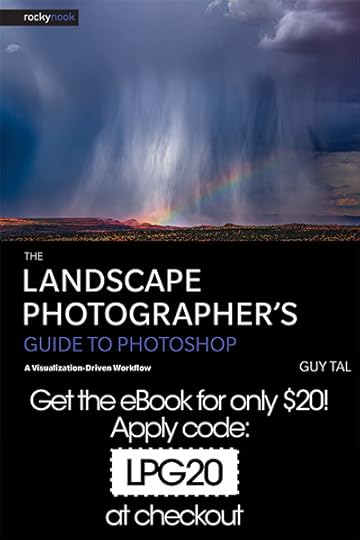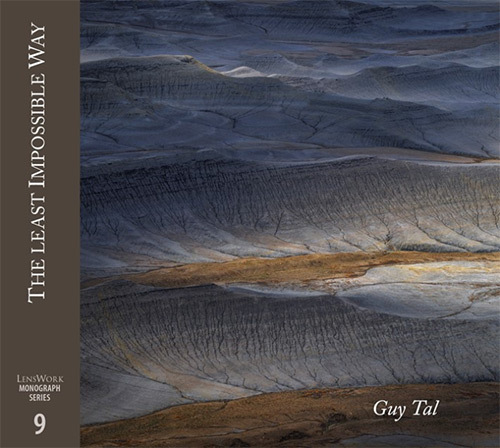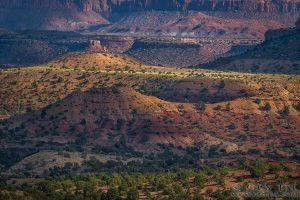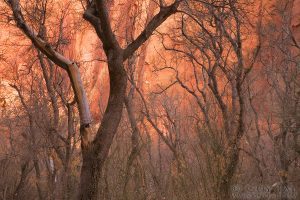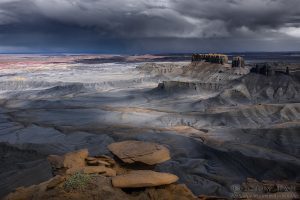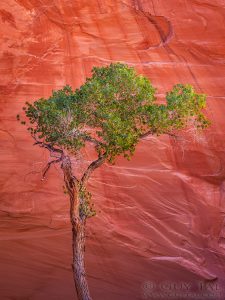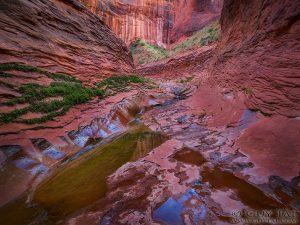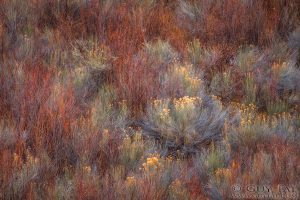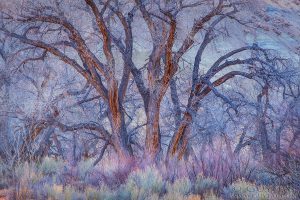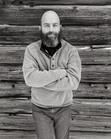Guy Tal's Blog, page 6
September 25, 2017
The Landscape Photographer’s Guide to Photoshop
Excited to announce that my new book is now available in electronic format. The print edition is not far behind. My publisher, Rocky Nook, is currently offering the electronic edition at a considerable discount:
September 6, 2017
LensWork Monograph: The Least Impossible Way
I have a limited quantity of my (now out of print) LensWork Monograph, titled, The Least Impossible Way. This is part of LensWork’s Monograph Series (#9 in the series) and is a 72-page soft-cover book containing a portfolio of my images and a couple of short essays about my work.
To purchase an autographed copy for $29.95 (US shipping included), click the image below or the “Buy Now” button.
Regrettably, I am currently only able to ship to US addresses. If you wish to pay by check, please contact me via email so I can reserve a copy for you.
September 3, 2017
Dimensions of Experience
Only by going alone in silence, without baggage, can one truly get into the heart of the wilderness. All other travel is mere dust and hotels and baggage and chatter. ~John Muir
I made fresh tracks for the last ten miles or so of a recently flooded two-track road in a largely anonymous part of the desert on my way to a favorite campsite overlooking colorful claylands—deposits of bygone days of great rivers and shallow seas. Today, a quarter billion years later (give or take), summers bring both hot dry days and spectacular thunderstorms to this high desert, which deter even the few who visit here in other seasons. Dodging deep ruts and flood debris, I arrived at the edge of a mesa and set up my camp while Millie the dog panted patiently in the shade of a nearby tree. When finished, I retrieved a refreshing beer from the ice chest and sat below an old pinyon pine to admire the view and the silence. Scattered around me were rock flakes indicating the former presence of Neolithic people, likely members of Puebloan or Fremont cultures, perhaps even older. People visited and lived in these parts for well over ten thousand years, yet their traces are mostly absent or negligible.
There are things you feel when alone in wilderness that challenge you emotionally and intellectually in ways not possible in the company of others, or in other settings. This is because, in the company of your own thoughts, without the distractions of the human-made worlds and the so-called human condition, even your conscious mind is powerless to avoid looking inward. In moments of reckoning, you are being interrogated and held to account by your most formidable critic—one you can’t hide anything from and whose judgment you cannot easily dismiss for such reasons as lack of trust or for failing to understand you. But this is also the reason this critic’s voice is one you should heed more than any other.
I wonder sometimes if people’s innate obsession with the opinions and antics of other people, which greatly attenuates, sometimes silences, one’s inner voice in favor of the tyranny of social conformity and expectations, is the reason for so many mythical tales of great souls wandering into the wild to seek revelations. Perhaps the fact that one’s inner voice is so easily distracted from when in the presence of others may also be the reason for attributing such revelations to supernatural origins rather than to one’s own mind struggling to assert rational thinking over the cacophony of the hive. Evolution made us social animals, and in the process also provided means for the collective to overwhelm one’s capacity for, and perceived value of, private inner experience.
It is a commonplace of all religious thought, even the most primitive, that the man seeking visions and insight must go apart from his fellows and live for a time in the wilderness. If he is of the proper sort, he will return with a message. It may not be a message from the god he set out to seek, but even if he has failed in that particular, he will have had a vision or seen a marvel, and these are always worth listening to and thinking about. ~Loren Eiseley
Photographers, I hate to admit, contributed a great deal to the perception that the experience of the wild can be reduced to appearances—to feats of geography and weather, to qualities of light, to visually interesting arrangements, to juxtapositions of colors and patterns and textures and lines and shapes. But such a perception is tragically lacking. Not only does it fail to convey other dimensions of the wild experience, but it fails in a greater sense to inform viewers who have not had such experiences that these dimensions even exist, let alone that they may possess greater powers to transform a life than any image or number of images can. But photography is not alone in such failures. Even the so-called conservation movement, advocating the preservation of the wild, fails utterly to acknowledge, educate, and campaign for the experience of wildness in all its dimensions.
Silence, solitude, anonymity, difficulty of access, remoteness, physical disconnect from the trappings of humanity, the need to rely on one’s skills, knowledge, and faculties for survival and comfort—all these are indispensable dimensions of the wild experience. And as we continue to “develop” parks and monuments, or even so-called “wilderness areas”—making them more accessible, more popular, more business-friendly, more family-appropriate, less risky, less demanding of commitment and skill and time, less anonymous, less mysterious, less detached—we also profoundly change the experiences they offer. And the result: as a society, we favor more people having lesser experiences to preserving the actual experience of wildness.
A wild experience is not only about seeing the wild, it’s not even about being in the wild, it’s about being wild in the wild. When living wildly, the very perception of one’s existence in the world is different from that of playing whatever role in whatever community one belongs to. In the manufactured world, time and distance are simple dimensions, metered in simple and equal units. In the wild, detached from expectations, judgment, schedules, human obligations, and the need for common denominators, time and distance have dimensions of their own. Time is not just measured in hours or minutes or seconds, but also in depth. Time passes at different rates depending on experience, and in disregard of what the chronograph says. Distance is measured in effort, in heat or chill, in sensory perceptions encountered as one traverses or studies the land, rather than in meters or miles. One hour is not like another hour. One mile is not like another mile. There are many more qualifications to distinguish one hour from another and one mile from another. And these perceptions—their variety and the subjective meanings we assign to them—are the true measures of life, which are not reducible to, or quantifiable in, simplistic terms like “hour” or “mile” or “year” or “kilometer.”
I find it a useful exercise, when in the wild, to let go of words altogether—to think without words, to experience without words, to not bother myself with how I will later describe—in words—the experience to others. Because “others” and “later” are the perspectives of outsiders looking in, removed from the experience, and often lacking a frame of reference. For such descriptions, memory will suffice after the experience had passed.
Let go of words; banish them if you have to. Just be. Feel the pulse of life in and around you without assigning names and categories, and without consideration for whether, or how, you may wish to share your perceptions with others. Words are symbols. We symbolize things to simplify them and to communicate them effectively and efficiently. But our perceptions, if we are to allow them the complexity, nuance, and ambiguity needed in order to be the subjective interpretations we each feel in our own way, are never identical to those of others, and neither are the private inner states they inspire in the singular amalgam of thoughts, emotions, beliefs, and psyche that is each of us—things nobody else can feel in exactly the same way, and that therefore have no words to adequately symbolize them. Words are lesser representations of the holistic experience, to be used when communicating outwardly, when lower common denominators are needed. But they are poor substitutes for the multi-sensory experience felt in the raw, as it happens, without attempting to describe it.
Language is a detriment, an earthbound limitation from which the poet suffers more than anyone else. At times he can actually hate it, denounce it, and execrate it—or rather hate himself for being born to work with this miserable instrument. ~Hermann Hesse
If you are wondering what I mean by my use of the term “wild experience,” and have never found yourself immersed in deep, wordless, contemplation when alone in a remote and wild place, it is unlikely that you will be able to understand what I say here. Even if you read every account—fictional or factual—about being in the wild, you will still not understand it. Consider giving yourself what may be among the greatest gifts you ever receive, and try being wild in a wild place. Free yourself from preconceptions, from anything having to do with other people, from the news, from conversation, from communications, from obligations and judgment, from traditions and opinions—from anything artificial save for the things you need for your own survival, and see what you find. It will not be what I, or anyone else, found. It will be you, in the most literal sense there is. Make yourself aware of all dimensions of experience, including mystery and fear, beauty and excitement, intuition and knowledge. Find your wild, rather than limit yourself to seeking “the” wild.
August 9, 2017
Conversation with Matt Payne
I very much enjoyed speaking with Matt Payne for his podcast, F-Stop Collaborate and Listen. You can listen to our conversation here:
July 16, 2017
Drawing The Line
In fact every photograph is a fake from start to finish, a purely impersonal, unmanipulated photograph being practically impossible. When all is said, it still remains entirely a matter of degree and ability. ~Edward Steichen
The only definition for art that I was able to come up with that is both unequivocally true and that also can be put to use to clearly delineate art from anything that is not art is this: art is the product of artists. This is because, in one context or another, practically any object or experience can be considered art, but not every person can be considered an artist.
Defining art as the product of artists also serves to appropriate the term to things created consciously by a human agent. As artificial intelligence advances in leaps and bounds, it may well be that machines will soon be able to manufacture artful, perhaps even creative, products, which indeed will be a spectacular technological accomplishment. But we will do well to exclude such developments from the definition of art at the outset, lest we risk losing what art is beyond mere aesthetics. Machine generated art may be indistinguishable from human made art to someone viewing it, but there is one aspect of art that no machine can ever replace: the inner experience of the artist.
I’m of the opinion that defining a thing as a work of art describes its function (at least within a given context and/or period of time) but should not be considered a value statement. I believe that there are many worthy things that are not art and that are as, or more, worthy than many great works of art. Documentary photography, for example, has been responsible for some of humanity’s greatest accomplishments, including the proliferation of information about, and awareness of, some of the pinnacles of existence and of human endeavors, both grand and terrible. Commercial photography is responsible for much of our industrial progress, our knowledge of what people and things look like even if we never get to see them in person, and much more. But why do these have to be art? It seems odd to me that many hijack the term art as a marketing label, or as an indication of elevated quality, creativity or other things, even when such things are decidedly absent, or irrelevant to the work’s intended use. When everything is art, nothing is art.
I’m of the opinion that what artists wish to express is of greater importance than the means they choose to express it with. As such, I consider such things as purity of process, tradition, or any other constraint that a photographic artist may choose to adhere to, as important to understanding the artist’s temperament, but otherwise less important than their reasons for creating their work in the first place. I am more interested in the why than the how.
Having made such statements before, I recognize that sometimes viewers may assume about my work what lawyers call, “facts not in evidence,” namely that my tolerance for what some may call “manipulation” suggests that I push the boundaries of (to borrow a term from Ansel Adams) “departure from reality” to a greater extent than I actually do.
I do, absolutely and unapologetically, create images that are departures from reality. In fact, I do not believe that any product created with the aim of representing (literally re-presenting) reality qualifies as art. The very origin of the term art is a Latin word implying something manufactured by human skill, rather than occurring naturally. But, I also wish to make clear that my departures may be far more nuanced than some may believe. I practice my work as self-expressive art, meant simply that in my images I wish to reflect a true, subjective, inner state. I unequivocally do not seek to manufacture images just for aesthetic beauty, nor to elicit emotional responses that I had not experienced at the time of making the image. And those inner states I wish to express most often are inspired by my experiences in wild places. And I do not wish for my work, or the emotions it expresses, to depart from those real experiences.
My goal of expressing my own inner states in my work, using natural beauty as a vehicle for such expression, rather than its ultimate goal, also explains the things I do not do. Images ensuing out of technological feats, such as aerial photography or renditions of the night sky that I am unable to see or relate to emotionally (at least not until after the image is made), while interesting to experience as a viewer, do not interest me as an artist. They may arouse an emotional reaction in the viewer, but they do not ensue out of an intuitive one. At least for me.
I also rarely create images in the company of others. This is because I am extremely introverted and do not experience emotions with the same depth and power when around people as I do when alone. No matter how beautiful the scene, if I feel uncomfortable, distracted, or self-conscious, I will not photograph it.
And so, although I do not presume to impose my boundaries on anyone else, nor claim that my reasons are in any way more “true” or valid than those of others, I draw my line for departing from reality at the extent that such departures distill and emphasize those aspects of an image that are conducive to the emotions I feel and wish to express, and that I hope to elicit in the viewer. The image in its aesthetic aspects, to me, serves as a conduit for real inner experiences and subjective feelings, making tangible things that otherwise will only be available to me, and offering a means of relaying them to others.
This is to clarify my own approach, and not in any way to disparage the works of others who choose to draw their lines elsewhere, or whose motivations in creating their works are different from mine. My reason for making these statements is that I find it eminently interesting to understand the motivations and choices of other artists, and I wish to encourage anyone engaged in producing expressive work to similarly think about and to articulate their own motivations in writing. As a viewer, it greatly enhances my experience of your work.
June 5, 2017
Reawakening
Nothing in the world is permanent, and we’re foolish when we ask anything to last, but surely we’re still more foolish not to take delight in it while we have it. If change is of the essence of existence one would have thought it only sensible to make it the premise of our philosophy. ~W. Somerset Maugham
I walked out of the canyon in the golden warmth of the late afternoon sun. It felt good to be out again, to have walked for a full day in a remote, lonesome and beautiful place. I arrived at the trailhead, such as it was—a random spot where I could leave my car by the side of a two-track road—shortly before sunset. After many hours of seeing nothing to indicate the existence of other humans, I emerged in a place that was still quite remote and where seeing others was very improbable; but I was by a road, by a vehicle, again within reach of that other world—a world that most people find comforting and sheltering but that to me has always been a mixed bag.
I felt elated to be reminded that such places as I had just visited are still out there, and grateful to savor what’s left of them and what’s left of me. On my way in, it was hard to ignore the “development” and the plethora of visitors encountered in once-lonesome places: places I have lost over the years. They are still there, on the map, on the ground, but their character and the experience of being there is no longer what I remember it to be; and they are no longer the wild, inviting, exciting, anonymous and peaceful friends they once were to me. As for me, I have been sick for well over a year, unable to write or photograph much. The places I knew are not coming back, at least not in my lifetime. But my health has improved and I am inspired again.
I am a loner, and always have been. I do not know, nor want, to be anything else. I revel in aloneness. I have little need for social interaction and I avoid it to the degree that I can. I am a philosopher in the classic sense of the word: a lover of knowledge, a seeker of answers and meanings, a logician. However, I will not pass for a philosopher in the academic sense. Philosophy was once synonymous with science, later adopted by theologians, and ultimately ended up like so many dissected lab specimens in the academy, and like such specimens it has also become sterile, lifeless and dull. On occasion, however, philosophy had the good fortune to be hijacked by freethinkers—scientists, politicians, artists and laypeople—obsessed with unraveling the great truths of existence, with finding another piece in an unsolvable puzzle. I wish to count myself among these.
I looked back at the canyon where I had spent the better part of the day. I walked among glowing sandstone walls and through crystalline pools, rested by twisted and tormented old trees, visited with delicate spring flowers soon to vanish, listened to the calls of wrens and sparrows and ravens, stalked lizards and butterflies and tadpoles. So many, so varied, so full of wonder are the experiences to be had in this landscape. I have read the accounts of others who explored this desert, but I did not come here seeking to feel like Powell or Abbey or Stegner or Ruess or anyone else. I came here wondering what this land would feel like to me, as me, and with the great hope that it would not feel to me as it did to others. And my wish was granted.
I am a visual artist, painfully aware of the crippling limitations of using just the sense of vision in expressing the many dimensions and sensations of my deepest thoughts and most satisfying experiences. Art to me is not just the pursuit of some idea of aesthetic perfection, but a means to a more meaningful and satisfying life. I strive to make beautiful images, but I am also taken aback when beauty is all that one feels when seeing my work. It is like complimenting a chocolatier for just the sweetness of his confections, or praising a vintner for the pleasantly tipsy feeling brought on by her libations. I wish for my work to embody some of what I felt, not just what I saw, and certainly not what you—the viewer, with your own sensibilities, knowledge and feelings that are different from mine—would have seen, or felt. I wish more people saw their way to the great joys of self-expression, and to those found in savoring the expressions of others; to the inner rewards of mindfulness, of discovery, of nuance and of complexity.
I fear those who fear complexity. I fear those who speak knowingly about things unknowable. I fear those who claim subjective perceptions as objective truths. I fear those unable to defend their actions and opinions by means of logic and reason. I fear those who advocate for some better future without ever taking the time to appreciate the present, to be present, to allow and to encourage others to be present. Most of all, I fear those whose morality is not founded, above all else, in compassion.
How temptingly convenient it is to remain in the shallows, to float the river of life on a raft of ignorance and cynicism and conformity, to wait out the clock. I realize what profound sensations and experiences, inspiration and discoveries that I was fortunate to feel—in person, with all senses, enhanced by knowledge and philosophy—and that I would never have felt if I did not pursue them, if I did not work for them, if I did not endure risk and effort and pain to attain them. There’s a degree of depth, I learned, that can only be earned by stepping outside the shelter of human conventions, conveniences and rituals. And once you are out and have mustered a degree of objectivity, you realize that the distinction between shelter and prison is not as clear as you might like to believe.
On a recent workshop, a fellow photographer asked me if I use my knowledge of visual expression to manufacture experiences for my viewers that are not founded in reality. I do not. In my work I wish to convey some of my own experiences, as real as they are in my own, subjective, mind. But I do not fabricate or fictionalize. Not because I dislike fiction, but because my real experiences are more moving to me, and more worthy of expressing, than anything I could make up. The philosopher, like the artist, and unlike the journalist, has no obligation to be objective. But, if his philosophy is to be of use to anyone—or even just to himself—he must frame his arguments so his readers know how his subjective conclusions were derived out of objective observation. A true philosopher also does not shy from having his conclusions challenged. On the contrary: if he is unable to defend them, and finds himself in error, he is a step closer to the truth.
In the heat of the day I sat in the shaded recess of a sandstone alcove at the foot of a steep wall. A pool of water rippled by the breeze caught the sun and reflected a dazzling display of dancing light onto the walls. I made a conscious effort to be mindful of little details: colorful pebbles in the water, small iridescent eddies appearing and vanishing, water skeeters and beetles, the hushed whisper of the wind, the quaking of leaves, the motion of grasses. I then closed my eyes and meditated for a bit. It seems odd that the experience of meditation—when one deliberately disconnects from the external world—feels so similar to the experience of mindfulness—when one deliberately focuses all attention on the external world. The defining characteristics of a meditative experience, I found, have less to do with the things you pay attention to, and more to do with the things you do not pay attention to: the self, others, the past and the future.
I made few images, attempting to apply skills not exercised in a while. It was hard, and satisfying. Indeed, there were many easier and just as aesthetically pleasing images to be made, but there comes a point when you have to get past the easy ones to remain inspired and challenged, to proceed down the path to whatever is there that is worth finding and that you know you will never find. But you are better the closer you get.
I recall other lives in other places. I recall escaping jobs and crowds and cities and traffic and politics to find solace among wild lands and wild lives. I recall in particular walking out of a business conference into a busy street, dressed in my “business casual” costume, and feeling frustratingly ordinary and acutely aware of the moments of my life slipping away. I recall wondering why I was trying so hard to make it work, to fit in. Why would I want to fit into this? I don’t even like it. Why am I trying so hard to convince myself that there isn’t something better to be had; and how would I know if I didn’t try? And now, even as I struggle to pick up where I left off, in what seems like waking up from a prolonged nightmare, I know the answer. There is.
Thank you for letting me ramble. Thank you for letting me announce to the world that I am writing again, and working again, and inspired again.
April 12, 2017
Quiet Adventures
This article was adapted from a piece I wrote for PHOTOGRAPH Magazine in 2015.
Home is not where you are born; home is where all your attempts to escape cease. ~Naguib Mahfouz
After three days in the canyon I finally settled into the rhythm of the place. Around 5am each day, just before first light, the birds would wake and start chirping. I pinpointed a rock pinnacle on the opposite canyon rim that caught the first of the sunlight each morning and aligned my sleeping pad so I could see it while still in my sleeping bag, sipping my morning coffee, which I brewed on a small stove I set up the night before within easy reach. I determined the optimal spot to read and write during the mid-day hours, between short meanders along the nearby creek. I identified the location of an owl’s nest in a small opening in the cliff across from the alcove that was my temporary home. Scattered rock flakes and an unusual concentration of scrub oak on a large sandbar a short walk away suggested the former presence of ancient people, later affirmed by the discovery of pottery shards bearing the unmistakable black and white patterns characteristic of ancestral puebloan culture (what some refer to as Anasazi). On my short walks I noted every plant and insect and bird and lizard, committing to memory those I could not recognize so I could look them up later. Each afternoon, light reflecting off the steep red walls ignited the narrow sandstone corridors in a magnificent orange glow, and a slight breeze helped dissipate the heat of the day and fill the air with the scents of water and early flowers and riparian vegetation. Each evening, in the last light, I watched sphinx moths hover around the scarlet blooms of a large mound of a nearby claret cup cactus. At night, I wrapped myself in my sleeping bag and watched as the celestial neighborhood traversed a sky free of light pollution, and thought deeply about things and people and ideas, making notes of things I wanted to write about. On this third day, just before the afternoon calm fell over the desert, I finished reading a book I brought with me. My legs no longer sore from the long hike in, I loaded the camera, a jacket and some snacks into a small day pack and headed into the narrow passages beyond, finally feeling ready to make photographs.
This has been my primary mode of practicing photography for some years now. When describing it to a photographer friend, his first reaction was that it did not seem like a very productive way to work, to which my instinctive response was this: you expect me to give up this just to have a few more files in my archives?
I refer to such excursions as my quiet adventures. I live in this desert and have learned its ways, which is not to say it doesn’t have the capacity to surprise me on occasion. My yearning for it in years when I lived in other places left me with little doubt about its powers to evoke in me emotions and images like nowhere else. So powerful was its draw that it became inevitable that I needed to live here, to be able to head out into the sandstone labyrinths and the high plateaus on a whim, without having to plan, without long hours on freeways, in airports or cramped planes, without a checklist of photogenic locations already photographed by others, and other barriers to the raw experiences of wildness and the creativity they inspire. With the deepening of familiarity also came a deepening of experience, of emotion and of life. Whether in solitude, or in the company of like-minded friends, I owe some of my most fond and profound memories to these places and to my quiet adventures in them.
Many who visit the desert I call home likely know that it is an easy place to love, and I make no claim of being unique in that. For me, however, even if given the opportunity to travel anywhere in the world, there is no other place I would rather visit or even photograph.
I hesitate to proclaim unequivocally that I am not a travel photographer, because travel is an ambiguous word. On a given outing I may drive and hike much farther than most do even on extended overseas trips. What I am not, however, is a tourist—an outsider—in the places I work. I am not particularly interested in travel for the sake of gaining glimpses into stories in which I am not an active character, where my mind may be distracted by the logistics of travel; by being an exception to the local culture and language; or by feeling restricted in where I can go, when and for how long. Instead, I seek to leave the human-made world behind altogether, and to work in the welcoming peace of anonymous places, many of which I discovered on my own wanderings and got to know in solitude, over time.
Although primarily an attitude toward place and experience, my reluctance to photograph in locations that I am not a part of ensues also out of my attitude toward photography in general. In images, I seek more than just visual appeal: pleasing configurations of visual elements; portrayals of landmarks or people that are inherently interesting or visually appealing without the photographer making them so; or repeating compositions already photographed by others, no matter how beautiful. Rather, I look for a deeper connection—to understand and to experience my subject matter in a sensory and visceral way, and to express the subjective sensations inspired by it; to become intimately familiar with it; to contemplate it. What I am after is not primarily “good” images, but the inner experience out of which such images may arise. To me, having such experiences is the highest privilege of the photographic artist, and the most rewarding reason to engage in making images. Conversely, an image I may make that did not ensue out of a memorable, intimate, experience does not excite me as much. If such images, even if magnificent in every other respect, were the sole reward for travel, I likely would have become bored with photography, and with travel, long ago.
Certainly there is pleasure and a sense of accomplishment in finding some pleasing visual order independent of one’s personal connection with a place or subject. To me, however, such accomplishments still fall short of those sensations of wildness—the sense of freedom and perfect solitude; the kinship with life and place; being acutely aware of the sensory and emotional joys of living at their most intense; and the sense of profound gratitude, not only for witnessing an occasional feat of beauty, but also for the experience in all its dimensions, and even if the camera never gets put to any use at all.
Having these places available and familiar to me, without the discomforts and limitations of international travel, means that I have the time to be mindful of all their little nuances; to study and explore and experiment; to come home empty-handed on occasion, knowing I can return in more favorable times and conditions; and to develop a complex relationship with a place, rather than having to settle for its superficial impressions. To my way of working and living, these quiet adventures are more appealing and rewarding than anything I may find in more exotic locales, where I am constrained to short-lived glimpses into stories that are not my own.
March 17, 2017
Endangered Experiences
Between ourselves and actual experience and the actual environment there now swells an ever-rising flood of images which come to us in every sort of medium—the camera and printing press, by motion picture and by television. A picture was once a rare sort of symbol, rare enough to call for attentive concentration. Now it is the actual experience that is rare, and the picture has become ubiquitous. ~Lewis Mumford
It is my habit to wake up multiple times in the night. On most nights I will see at least once every hour on the clock. Usually I drift back to sleep, but not this time. I’m not certain what prompted me to slip out of my sleeping bag and walk out into the desert, bathed in the blue light of a half-full moon at this late hour. Maybe it was again feeling the pleasant sensation of desert air on my skin, gentle and without the cruel bite of below-freezing temperatures. Winters are long here.
I surveyed the ghostly scene. It was quiet and blue and bright enough to see a long ways out. No artificial light or sound. I sat on a rock and considered how incredibly improbable it is for me to be here, now. Despite having been born on the other side of the globe, having experimented with different careers and interests, and having experienced many serendipitous events throughout my life, I still can’t help feel—against logic and reason—that my being here is not entirely coincidental, that something innate brought me here, perhaps not necessarily to this place, but to a desert on a silent blue night.
How odd it is that I get to experience this tiny slice of reality, in this place, at this time, from this vantage point on the outer crust of this little planet, a member of this strange species, with these means of sensory perception and this mind capable of abstracting, examining and philosophizing, gazing into the blue depths of eternity and wondering what may be out there.
Of course, this is but one of a great many moving experiences I am fortunate to have had in wild places. Feeling perfectly imperfect, immersed in beauty and melancholy, sharply aware of my fortunes and tragedies, my gratitude and sadness, the life I lived and the hourglass of my days draining away, a grain at a time. My senses elate me, and my thoughts taunt me. The grandeur calms me down and assures me that I am of little consequence, while my inner turmoil—the demons and memories and doubts—burn me from the inside. I can say unequivocally that my most meaningful times on this Earth are those I can describe not just as beautiful, but as painfully beautiful.
On a recent visit to a favorite place I was surprised to realize that the once-bumpy dirt road has been smoothed and widened. A once-obscure trailhead flattened, graveled, fitted with a pit toilet and a sign that prohibits camping. To some these may seem like conveniences, but to me it is the end of the place I used to know. Its location is the same, its features as I remembered them, but its experience of solitude and wildness is no longer. It is no longer the same place, and no longer a place I will likely return to. I have lost several of them in the last few years to similar “improvements,” and a couple to being “discovered,” ironically by fellow photographers.
We often express concern for the welfare of future generations, using it (at least partially) as reason to justify ongoing technological progress, larger cities and corporations, more jobs, more roads, more gadgets, more houses, more means of interaction and communication. And yet, we cannot ignore the fact that we are also taking a great risk on behalf of future generations, robbing them of both places and experiences available to us that they may never be able to partake in.
I am quite certain that our physical and intellectual powers, impressive as they are in the progression of life on this tiny planet, will never be capable of unraveling the greatest mysteries of existence. I also believe that we cannot persist with the attitude of perpetual growth for much longer. Technology run amok may ultimately prove to be a sharper blade than our greedy, power-hungry species can be trusted to yield.
It seems to me that some generation will have to make the painful transition from growth to sustainability in order to persist. Some generation will have to knowingly decide when enough is enough, when it’s time to hit the brakes. I’m convinced that this generation should be us. Not because we have accomplished the knowledge or wisdom to do so, but because we are close to the point when such a transition can no longer be made. In fact, there is no small amount of evidence to suggest that we may already be past that point. But then again, this is exactly how new and more fit species are allowed to rise to the top spot. It’s how we got here, as did many species before us, and most likely, many more will after us.
As we leap to the defense of endangered species and communities, endangered industries, endangered cultures, etc. We should not lose sight that many profoundly valuable experiences are also endangered, and may soon no longer be possible.
I am a firm believer that the true measure of life is in experience. The more numerous, emotional, meaningful and profound one’s experiences are in the course of living, the grander their life. If we are indeed to be held honest about caring for future generations, are we truly doing right by them? Or are we leaving them with material comforts but with a much more limited span of powerful experiences than we are privileged to have? With more means but fewer ends?
February 22, 2017
Not That Kind of Photographer
What’s in the frame of the photograph matters artistically, to be sure, but what’s outside the frame can destroy it. ~Philip Hyde
One of the most pervasive problems facing creative photographers, and especially those of us working with natural aesthetics, is that many assume we all do the same thing—spend our days in pursuit of anything photogenic, hoping to get lucky enough to “get the shot.”
Over the years I had to explain many times that my brand of photography is aimed at creative expression, rather than chasing after fortuitous phenomena. Also, I often have to explain that just because I’m a photographer, doesn’t mean I know, or care about, everything having to do with photography. I am not a commercial photographer or a stock photographer; I know little about photographing people or products or events; and I do not pursue “decisive moments” on city streets. With few exceptions, I have little interest in traveling to exotic places outside my home in the American West; and I am unable to offer much help with studio lighting, video, time lapse or other techniques I don’t use in my own work. Which is not to say I don’t enjoy such photography when done well by others.
These days, thankfully, most people interested in photography recognize that some of us specialize in particular styles and subject matter, and that there is more to being a photographer than having general expertise in operating photographic equipment or hopping from one “must see” place to another. Today, when I present myself to fellow photographers as an artist, or a fine-art photographer, most of them understand what my work is, and is not.
It is with great regret that on some recent occasions I felt the need to distinguish myself yet further from others who, like me, also work with natural subjects; and even from some who proclaim themselves to be artists. I am referring in particular to those photographers who consider “getting the shot” as their primary motivation, and who, in the course of their work, are willing to bend or break laws and regulations, disregard the sanctity of places and the dignity of people, shamelessly plagiarize the works of others for profit or bragging rights, operate commercially without required insurance or permits, lead clients to places where such guiding is prohibited, and compromise the experience of others. I am not that kind of photographer, either.
As I said in other times: if I need to compromise my experience, the experience of others, or the welfare of the places, life and things I photograph in order to “get the shot,” then to hell with the shot.

